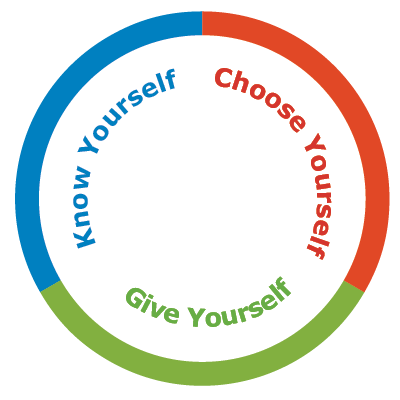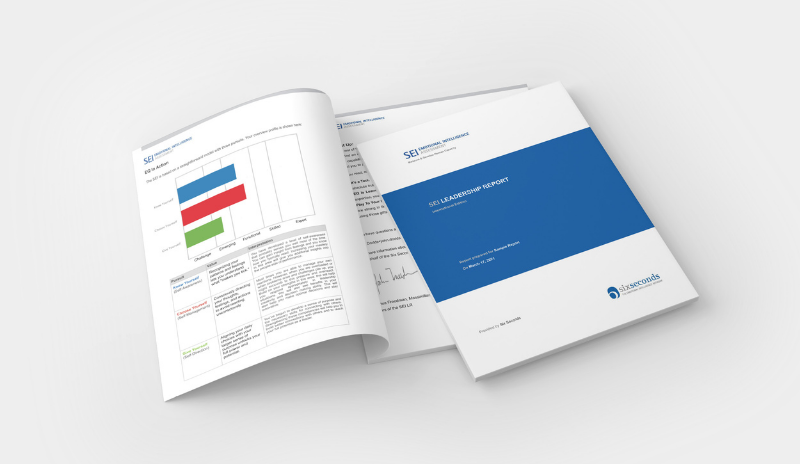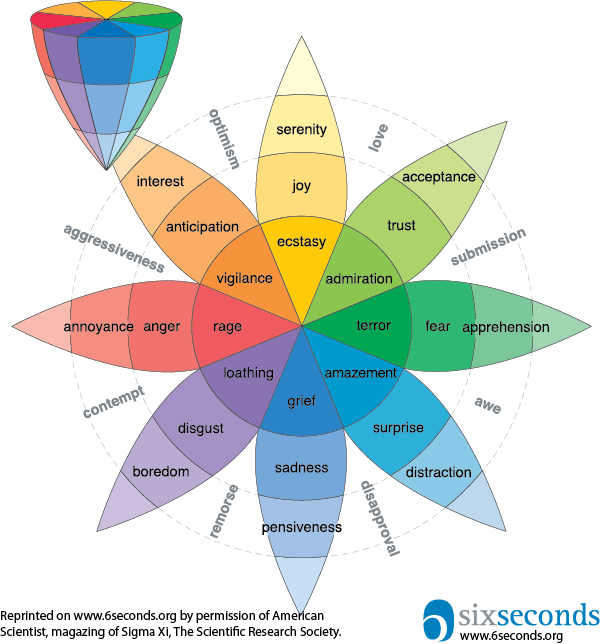The Six Seconds Model of Emotional Intelligence: What It Is and How to Use It (+ PDF)
What is emotional intelligence—and how do you actually use it in real life?
Emotional intelligence (EQ) is the capacity to blend thinking and feeling to make optimal decisions—which is key to having a successful relationship with yourself and others.
In 1995, Daniel Goleman published a groundbreaking book: Emotional Intelligence: Why It Can Matter More Than IQ. In it, Goleman posits that emotional intelligence is as important as IQ for success, including in academic, professional, social, and interpersonal aspects of one’s life. But as that book popularized the phrase and idea, one question came up again and again from people all around the world:
“This makes so much sense… but how do I practice emotional intelligence?”
That question led to the creation of Six Seconds—and this model.
Developed in 1997 by a team of educators and researchers, the Six Seconds Model of Emotional Intelligence provides a practical and simple way to learn and practice emotional intelligence. Instead of just describing EQ, this model was designed as a process—a way to actually build emotional intelligence, moment by moment, in everyday life.
What you’ll find on this page
➔ Overview of the Six Seconds Model
➔ Know Yourself: Grow self-awareness
➔ Choose Yourself: Improve decision making
➔ Give Yourself: Connect with purpose
➔ How Do You Practice Emotional Intelligence?
➔ Want to Go Deeper? The Six Seconds Emotional Intelligence Assessment (SEI)
➔ Plutchik’s Wheel of Emotions
➔ FAQ Section
Designed for Action:
Overview of the Six Seconds Model of Emotional Intelligence
Most emotional intelligence models describe what EQ is. The Six Seconds Model goes a step further: it shows you how to practice emotional intelligence in daily life.
At the heart of the Six Seconds Model are three important pursuits that form a cycle of growth:
-
Know Yourself:
To become more aware – noticing what you do -
Choose Yourself:
More intentional – doing what you mean -
Give Yourself:
And more purposeful – doing it for a reason

Built around three core pursuits—Know Yourself, Choose Yourself, and Give Yourself—this model offers a clear, practical process to grow emotional intelligence. It’s not a fixed trait or personality type, but a set of skills you can develop over time. At the core, emotional intelligence is something to BE. By being more emotionally intelligent, smarter with feelings, you will more accurately recognize emotions in yourself and others. This data will help you make decisions and craft effective solutions to the “life puzzles” you face each day. It’s also important to put it in action – hence the verbs. The three pursuits are actions and “under” the three pursuits live eight specific, learnable, measurable competencies. They’re measured through the Six Seconds Emotional Intelligence Assessment – or SEI. Here are the three pillars and eight competencies – with definitions below:
The Six Seconds Model of Emotional Intelligence
Know Yourself
Clearly seeing what you feel and do.
Emotions are data, and these competencies allow you to accurately collect that information.
Competencies:
– Enhance Emotional Literacy: Accurately identifying and interpreting both simple and compound feelings. Learn more →
– Recognize Patterns: Acknowledging frequently recurring reactions and behaviors. Learn more →
Choose Yourself
Doing what you mean to do.
Instead of reacting “on autopilot,” these competencies allow you to proactively respond.
Competencies:
– Apply Consequential Thinking: Evaluating the costs and benefits of your choices. Learn more →
– Navigate Emotions: Assessing, harnessing, and transforming emotions as a strategic resource. Learn more →
– Engage Intrinsic Motivation: Gaining energy from personal values & commitments vs. being driven by external forces. Learn more →
– Exercise Optimism: Taking a proactive perspective of hope and possibility. Learn more →
Give Yourself
Doing it for a reason.
These competencies help you put your vision and mission into action so you lead on purpose and with full integrity.
Competencies:
– Increase Empathy: Recognizing, connecting with, and appropriately responding to emotions. Learn more →
– Pursue Noble Goals:Connecting your daily choices with your overarching sense of purpose. Learn more →
Before you read on, we thought you might like to download our free Practicing EQ eBook. A perfect introduction to the Six Seconds Model, these evidence-based exercises will not only enhance your ability to understand and work with your emotions, but will also give you the tools to foster the emotional intelligence of your clients, students or employees.

Know Yourself: Grow Self-Awareness
Clearly seeing what you feel and do.
Emotions are data, and these competencies allow you to accurately collect that information.
Know Yourself is about recognizing and understanding your own emotions and behaviors – your strengths and challenges, patterns and desires. It’s the foundation of emotional intelligence. You can’t manage what you don’t understand.
Building self-awareness means developing emotional literacy—the ability to accurately name and interpret what you feel. It also involves reflecting on your emotional patterns and becoming more conscious of how your emotions influence your thoughts and actions.
With greater emotional self-awareness, you gain clarity. You make better choices, improve communication, and increase your emotional intelligence in every area of life.
There are two competencies, or skills, in Know Yourself: Enhance Emotional Literacy and Recognize Patterns.
Enhance Emotional Literacy: Accurately identifying and interpreting both simple and compound feelings.
Recognize Patterns: Acknowledging frequently recurring reactions and behaviors.
Choose Yourself: Improve Decision Making
Doing what you mean to do.
Instead of reacting “on autopilot,” these competencies allow you to proactively respond.
Choose Yourself is about navigating your emotions and actions consciously. It’s about creating space between stimulus and response—and choosing how you show up. Taking intentional steps, which involves impulse control, optimism, navigating emotions, and aligning your actions with your values. It’s about responding instead of reacting. When you build these skills and habits, you gain greater autonomy, resilience, and confidence. You become more adaptable in the face of stress or uncertainty—and more aligned with your goals.
There are four competencies, or skills, in Choose Yourself:
Apply Consequential Thinking: Evaluating the costs and benefits of your choices
Navigate Emotions: Assessing, harnessing, and transforming emotions as a strategic resource.
Engage Intrinsic Motivation: Gaining energy from personal values & commitments vs. being driven by external forces.
Exercise Optimism: Taking a proactive perspective of hope and possibility.
Give Yourself: Connect with Purpose
Doing it for a reason.
These competencies help you put your vision and mission into action so you lead on purpose and with full integrity.
Give Yourself is about connecting with others and contributing with intention. It’s where emotional intelligence becomes a force for good. When you Give Yourself, you are clear and full of energy so you stay focused why to respond a certain way, why to move in a new direction, and why others should come on board.
This pillar develops empathy, compassion, and a sense of purpose. It’s about understanding others’ feelings, listening deeply, and acting in ways that support meaningful connection and shared growth. Practicing emotional intelligence through empathy and purpose leads to stronger relationships, more effective leadership, and a more values-driven life.
There are two competencies, or skills, in Give Yourself:
Increase Empathy: Recognizing, connecting with, and appropriately responding to emotions.
Pursue Noble Goals: Connecting your daily choices with your overarching sense of purpose.
The Six Seconds Emotional Intelligence Assessment (SEI): Can You Measure and Grow EQ?
Based on the Six Seconds Model of Emotional Intelligence, the Six Seconds Emotional Intelligence assessment, or SEI, is the world’s leading EQ assessment. Taken by over 500,000 people worldwide, the SEI turns emotional intelligence theory into action with impactful, actionable reports.
SEI Leadership Report
Download a free sample report today:

Plutchik’s Wheel of Emotions and the Six Seconds Model
At the heart of emotional intelligence is this idea:
Emotions are data.
They’re not good or bad—they’re signals that help us navigate our inner and outer worlds. That’s why we use Plutchik’s Wheel of Emotions in many of our emotional intelligence trainings. It’s a powerful visual tool that helps people increase emotional literacy—an essential part of Know Yourself, the first pursuit in the Six Seconds Model.
Plutchik’s model identifies eight core emotions (like joy, fear, anger, and trust) and shows how they intensify or combine into more complex feelings. For example, “apprehension” can grow into “fear,” which might become “terror”—or blend with another feeling to become something else entirely.
Using the Wheel helps people:
-
Recognize subtle differences in what they feel
-
Expand their emotional vocabulary
-
Avoid judging emotions as “bad” or “negative”
-
Understand that all emotions carry useful information
By seeing emotions as data, not distractions, we empower people to respond with greater insight and intention. That’s what practicing emotional intelligence is all about.

Want to Get Started Practicing Emotional Intelligence?
Want to learn more about the Six Seconds Model of Emotional Intelligence and how to start practicing? Get your free 44-page eBook today.
What’s included:
- Free Plutchik Wheel of Emotions poster for your office or classroom
- Dozens of activities and exercises to practice emotional intelligence
- Dozens of words for feelings to grow your emotional literacy

Frequently Asked Questions (FAQs)
Here are answers to frequently asked questions:
What Is Emotional Intelligence?
Emotional intelligence (EQ) is the ability to recognize, understand, and manage emotions—both your own and those of others. It helps you make thoughtful decisions, build strong relationships, and lead with purpose. Learn more →
Why Is Emotional Intelligence Important?
Studies show that emotional intelligence is a strong predictor of both personal and professional success. And as artificial intelligence outperforms human experts in a wide variety of tasks, emotional intelligence skills will become even more valuable.
Can Emotional Intelligence Be Learned?
Yes! Emotional intelligence is not a fixed trait—it’s a set of skills you can learn and develop at any age.
How Does the Six Seconds Model Work?
The model includes three core pursuits: Know Yourself, Choose Yourself, and Give Yourself. Each one helps you build specific emotional intelligence competencies. It’s practical, measurable, and designed for real-world use.
What Tools Can Help Me Practice EQ?
We offer a free Practicing EQ ebook with exercises you can start using today. You can also explore the SEI assessment, our validated emotional intelligence test that provides personalized insights and development strategies.
Join us for an upcoming webinar!
Save your seat today for one of our upcoming global livestreams:
[events title-or-tag=’global’]
What’s new in emotional intelligence?
Leading Change in Times of Uncertainty: Why Managing Transitions Matters More Than Strategy
Leading change in times of uncertainty requires more than strategy. Learn why emotional transitions, trust, and purpose drive sustainable change.
The Holidays Can Be Something We Make, Not Something We Survive
Discover how emotional intelligence can ease holiday stress, reshape old patterns, and help you create traditions that feel meaningful, supportive, and truly yours.
Emotion AI: A Leader’s Guide to Use Emotional Intelligence for Effective AI Adoption and Change Management
AI adoption challenges are emotional before they’re technical. Learn how fear, curiosity, and emotional intelligence shape whether AI succeeds in your workplace.
Emotional Intelligence in Healthcare: A Quick Check-In Guide to Improve Patient Care and Reduce Burnout
Discover how emotional intelligence can help healthcare professionals reduce burnout, strengthen teamwork, and improve patient care.
From Challenges to Change: 3 Life Lessons I Learned from Unlocking EQ
Discover how the Unlocking EQ course helped transform challenges into growth, connection, and purposeful living through three powerful life lessons.
Leading Your Team Through Change
When facing challenges leading team change, increasing trust, vitality and purpose are key factors to success.
- Leading Change in Times of Uncertainty: Why Managing Transitions Matters More Than Strategy - December 28, 2025
- Emotion AI: A Leader’s Guide to Use Emotional Intelligence for Effective AI Adoption and Change Management - December 2, 2025
- Leading Your Team Through Change - November 10, 2025






